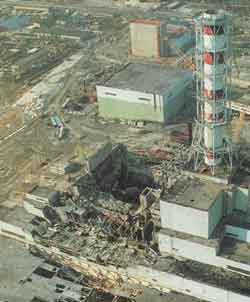Twenty years after Chernobyl
 I remember quite well the days after April 26, 1986, when human error and the lack of any disaster preparedness planning led to the worst nuclear accident in the short history of this horrific technology. When reactor no. 4 of the V.I. Lenin Memorial Chernobyl Nuclear Power Station melted down 20 years ago, it released 400 times the amount of radioactivity released by the Hiroshima bombing in the form of a plume that travelled across Europe and released its “payload” in the form of radioactive fallout.
I remember quite well the days after April 26, 1986, when human error and the lack of any disaster preparedness planning led to the worst nuclear accident in the short history of this horrific technology. When reactor no. 4 of the V.I. Lenin Memorial Chernobyl Nuclear Power Station melted down 20 years ago, it released 400 times the amount of radioactivity released by the Hiroshima bombing in the form of a plume that travelled across Europe and released its “payload” in the form of radioactive fallout.
We were told that we can’t drink milk or eat eggs. We were told that we had to stay inside. For days nobody knew for sure what was going on, because the Soviets (remember them?) would not fess up to what had happened. I remember endless discussions about what was safe to eat and what was not. A huge freight train was loaded with radioactive milk powder and travelled all around Germany, but no city allowed it to stay. Eventually this train just disappeared.
Today, there are 443 nuclear power plants in operation worldwide, and 27 under construction. We live within 50 miles of one. These plants produce waste material that will be extremely toxic and radioactive for thousands of years – what a great legacy to leave to our children and future generations. Here’s our toxic, radioactive trash, kids – don’t loose it! And what guarantees do we have that there won’t be another Chernobyl? “Trust us” they say. “We’re careful,” they say. Yeah right. So far they (we) were just lucky – unlike the 336,000 people in Ukraine and Belarus who had to be re-settled after Chernobyl – and unlike the thousands who died as a direct result of the catastrophe.